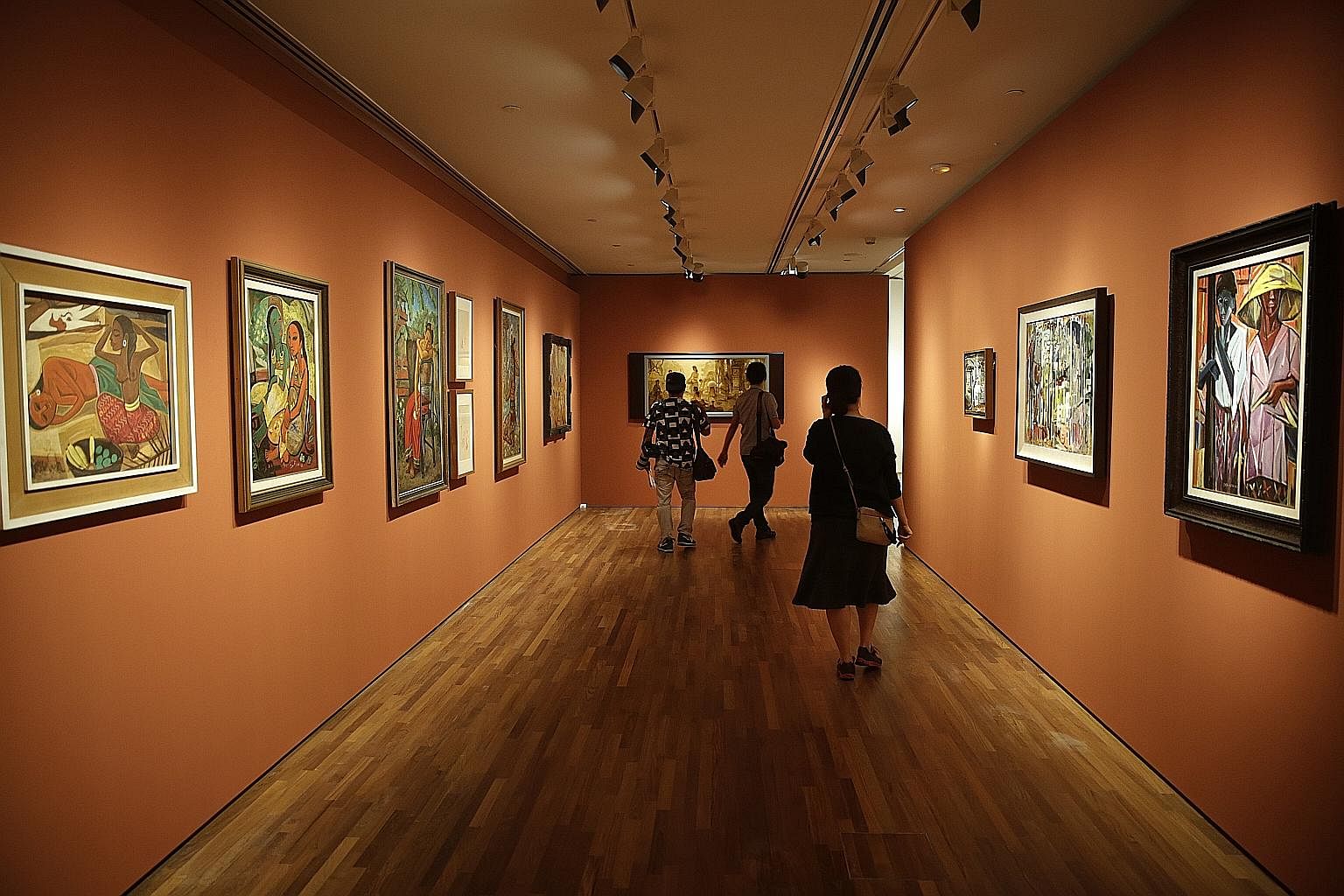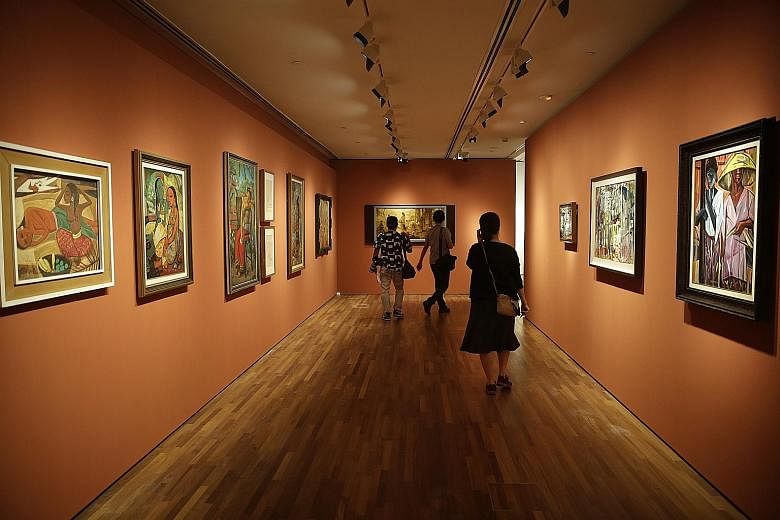When the National Gallery Singapore opened last November in the former Supreme Court and City Hall buildings with great fanfare, it marked a major milestone in Singapore's museum scene.
A decade in the making, the launch of the $532 million museum capped a year of significant developments in the museum landscape. This included the opening of the Indian Heritage Centre in Campbell Lane, the launch of the public gallery at the Lee Kong Chian Natural History Museum, as well as major revamps of the National Museum of Singapore and the Asian Civilisations Museum.
These brick-and-mortar changes follow the move in 2013 to make museum admission free year-round for Singapore citizens and permanent residents. The concession applies to permanent galleries and some special exhibitions at 13 museums and heritage institutions, including the Singapore Art Museum and National Gallery.
Such developments in recent years have transformed the museum landscape and brought more than cosmetic change. They have breathed new life into it by providing fresh avenues and opportunities for the public to become more aware of culture and the arts and to deepen their appreciation of it.
The National Gallery, for example, has proven to be more than an imposing home for the largest public collection of modern art in Singapore and South-east Asia. Its expansive, permanent exhibitions on the art of South-east Asia and Singapore, from the 19th century to the present - hitherto absent from the museum scene until its opening - offer a curatorial narrative that probes the notion of South-east Asia and its art.
The museum's scope, however, is not limited to visual art. It has looked to other forms of art and culture, including plays, music, dance and film to help audiences explore its collection.

In May, it commissioned five award-winning South-east Asian film directors, including Singapore's Eric Khoo, to create short films inspired by works in its collection.
While the initiative is new, this multidisciplinary approach to art and culture is not a first for museums here. The gaining momentum shows how these institutions are working to broaden public perception of art and culture and foster creative exchange.
The ArtScience Museum, which opened in 2011 at the Marina Bay Sands, has sought to present the possibilities of art and culture when they intersect with science and technology, through exhibitions such as its new permanent show, Future World.
-

About The Big QuizThis primer is part of The Straits Times' initiative to discuss issues of national concern.
Each Monday, the paper's journalists will address burning questions in the Opinion section, offering Singaporean perspectives on complex issues.
The primers, as well as five campus talks helmed by editors and correspondents, are part of this paper's outreach programme called The Straits Times-Ministry of Education National Current Affairs Quiz, nicknamed The Big Quiz.
The nationwide event, whose presenting sponsor is the Singapore Press Holdings Foundation, aims to promote the understanding of civics among pre-university students.
Yishun Junior College won the first round, held at Innova Junior College on April 6. Tampines Junior College won the second round, held at Victoria Junior College on April 20, while Catholic Junior College won the third round, held at Anglo-Chinese Junior College on April 27.
NUS High School of Mathematics and Science won the fourth round, held at River Valley High School on May 18.
The last talk by an ST journalist and quiz round will be held on Wednesday at Raffles Institution.
•For more information on the quiz, go to www.straitstimes.com tags/the-big-quiz
•For more information on the ST Schools programme and its offerings, visit www.straitstimes.com/stschools
The digital art show was realised in collaboration with the 400-strong collective, teamLab, from Japan. The collective, which includes artists, programmers, engineers and mathematicians, present sophisticated technology and complex natural phenomena as immersive, interactive and visually arresting art. One work, Crystal Universe, uses more than 170,000 LED lights, strung floor to ceiling in a gallery, to display astrophysical phenomena, which visitors can control using a smart device.
This seamless connection between art, culture and contemporary life has been increasingly highlighted through museum programmes and events.
When the Asian Civilisations Museum unveiled the first phase of major renovations last November, the occasion was marked by a 24-hour celebration at the museum. The public was invited to eat, sleep, play and party there.
The Singapore Art Museum has similarly worked to bring art and culture closer to the man in the street.
Its 5 Stars exhibition, which opened last year, drew inspiration from the values embodied by the stars in the Singapore flag. It spawned a series of round-table talks that had experts from different fields, including urban artist Samantha Lo, Paralympian swimmer Yip Pin Xiu and lawyer Samuel Seow speak about how such values as equality and justice influence the way they live and engage with society.
While the young have long been a focus of education and outreach at museums, the makeover of the landscape has introduced new ways of nurturing an appreciation of art and culture.
At the Keppel Centre for Art Education at the National Gallery, interactive visual displays and hands-on art-making sessions replace worksheets to encourage children and youth to experience art through play.
Its installation, The Enchanted Tree House by artist Sandra Lee, for example, features floor-to-ceiling drawings of landscapes that aim to evoke the sense of walking into a painting for those aged five to 12.
The National Museum also had a corner dedicated to children aged three to seven that featured interactive exhibits and hands-on activities. The space, Play@NMS, ran from 2014 to last December. It will return this year as an improved and enlarged family wing.
The evolving museum landscape has clearly set its sights on connecting with the masses. But to what extent has it succeeded in deepening appreciation of culture and the arts?
This outcome is challenging to measure and track. It is non-tangible and may surface only in the long term. But an available indicator, which may shed some light, is museum attendance.
The numbers, for one thing, point to the museums' ability to interest the public in their offerings and woo them through their doors. Visitor figures also suggest the reach and potential impact of the museums' efforts to grow appreciation of art and culture.
According to the latest statistics from the National Heritage Board, the number of Singaporeans and permanent residents who visited its seven museums and heritage institutions, including the National Museum and Asian Civilisations Museum, grew steadily from 535,000 in 2012 to 810,300 in 2014.
Recently, the National Gallery welcomed its millionth visitor, seven months after it opened.
Apart from museum attendance figures, the latest statistics from the 2013 National Population Survey on the Arts also provide a gauge of the public's perception of the arts and their participation in it.
The survey, conducted by the National Arts Council, shows that the percentage of those who express interest in the arts fell from 36 per cent of the respondents surveyed in 2011 to 28 per cent in 2013. On the other hand, the percentage of respondents who said that they are not interested in the arts increased from 27 per cent to 39 per cent in the same period.
Among those who did not attend arts events, their top reasons include the belief that such events are not relevant to them and that the arts were hard to understand.
The responsibility of nurturing understanding and appreciation of culture and the arts in society does not rest solely on museums. That said, they have a role to play and they have contributed in this area by offering programmes and events that are accessible, engaging and which cater to different segments of the community.
They still have some way to go in growing public appreciation of culture and the arts, but their major makeover in recent years has given them a firm footing for the next lap.

Have a burning question related to this week's Primer topic?
E-mail us at askST@sph.com.sg


